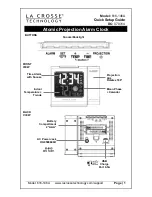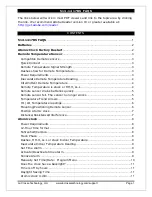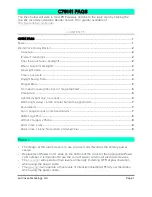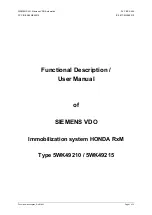
OPERATION AND TESTING
Smoke alarms are an important safety device in the home. It is import-
ant to check them regularly to ensure they are operating correctly.
Regular Mode
When there is no smoke present, the red LED should flash every
32 seconds indicating the alarm is operating correctly.
Alarm Mode
When the alarm detects smoke, the red LED will flash once per
second and the alarm will sound loudly. The flashing LED and alarm
will continue until the air is cleared.
Fault Mode
The alarm will generate a ‘chirp’ every 32 seconds indicating a fault.
TESTING YOUR SMOKE ALARM
It is recommended that you test your smoke alarm once a week to
ensure the smoke alarm is working correctly. Test by pushing the
test button on the cover. The alarm will sound if the alarm, electronic
circuitry and battery are working. If no alarm sounds, the smoke alarm
has a defective battery, or another fault.
Warning:
Do not use an open flame to test your alarm.
You could damage the alarm or ignite combustible
materials and start a structure fire.
LOW BATTERY POWER
Should your smoke alarm have a low battery the unit will emit an
audible ‘chirp’ once every 32 seconds and the red LED light flashes
once at the same time. When this occurs you must replace the alarm
immediately. Your smoke alarm will continue to warn of this low battery
for at least 30 days. However, failure to change the alarm after this time
would mean your smoke alarm may have insufficient power to alert
you in a real fire situation.
NOTE: When the alarm is removed from the mounting plate it will
automatically deactivate and the low power warning chirp should stop,
allowing you to dispose of the alarm.
Warning:
Your smoke alarm requires the battery to have
sufficient capacity of power to operate correctly.
SILENCE ALARM
If your smoke alarm emits the full alarm signal and you are not
testing the unit, the smoke alarm is warning you of a potentially
dangerous situation that requires your immediate attention. Only use
the alarm silence function after making sure that there is no ongoing fire
emergency situation.
Do not block the vents on the alarm or disable the smoke alarm in
any way as this will remove your protection.
Smoke alarms can sometimes react to cooking fumes or other non
emergency situations. In the event of a known false alarm your smoke
alarm can be temporarily silenced by pressing the test button. Your
alarm will automatically return to full sensitivity
within 8 minutes
.
1. Press and release the silence button, the alarm sound will stop.
2. Your alarm will silence and enter into a reduced sensitivity
reset cycle for approximately 8 minutes.
3. During the reduced sensitivity reset cycle, the red LED will flash
every 8 seconds indicating it is running in silent mode.
4.
Your alarm will automatically return to full sensitivity on
completion of the reset cycle and the red LED will revert to flashing
once every 32 seconds.
Warning:
Never ignore any alarm. Ignoring the alarm may result
in injury or death. If your smoke alarm activates and you are not
absolutely certain of the source of the smoke, get everyone out
of the house immediately.
ROUTINE MAINTENANCE
Like other electrical accessories in the home, smoke alarms
require maintenance to ensure efficient and effective operation.
Proper maintenance can also reduce the likelihood of false alarms.
1. In addition to weekly testing, the alarm requires cleaning at least
once a month to remove dust, dirt, or debris.
2. Using a vacuum cleaner with the soft brush vacuum all sides and
cover of smoke alarm device.
NOTE: Do not attempt to remove the cover to clean inside. This will
affect warranty.
Warning:
1. Photoelectric smoke detectors can reduce the likelihood of a
disaster, but they cannot guarantee a 100% safety.
2. To ensure your maximum security, please install all smoke
detectors exactly according to this manual.
3. Keep the detectors clean. Do not allow dust to accumulate and
test them at least once a week.
4. If they are not working properly replace them immediately.
BATTERY REPLACEMENT
The power for the smoke alarm is supplied by a 9V battery.
The battery should last at least 1 year under normal operating
conditions.
Warning:
Test the smoke alarm for correct operation using the test facility
whenever the battery is replaced.
Recommended battery replacement -
Carbon Zinc Battery: Pairdeer 6F22.
1. Remove the body of the alarm from the bracket by turning it
counter-clockwise.
2. Replace the old battery by connecting the new battery to the
power connector.
3. Fit the battery and attach the body of the alarm to the bracket
turning it clockwise.
4. Test the smoke alarm using the test button. The sound pattern is
3 short beeps-pause 1.5 seconds, repeated.






















